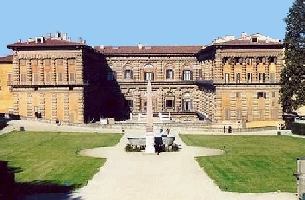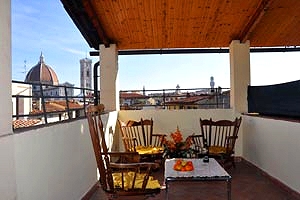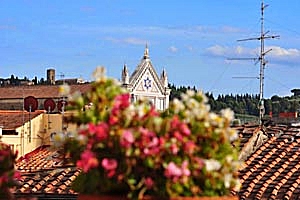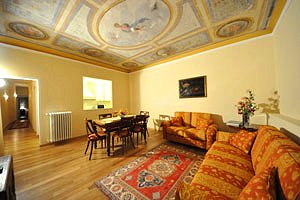The Pitti Palace in Florence

Florence - Palazzo Pitti
Most of the internal decoration was also executed during the 17th century by Giovanni da San Giovanni, Pietro da Cortona, il Volterrano, Antonio Domenico Gabbiani and Sebastiano Ricci.
As regards the domestic life inside the palace, we know that it was the home of several components of the family who were distributed in different private apartments. The rooms on the left wing belonged to the Grand Duke, while those on the right side were used by the heir. The lateral wings housed the apartments of their wives. The rooms on the second floor contained the large library, while the side rooms were used for the children. The left side on the ground floor housed the apartment that the Grand Duke used in summer.
Today, the palace and the Boboli gardens house the Palatine Gallery, the Silver Museum, the Museum of Modern Art, the Costume Gallery, the Porcelain Museum and the Museum of Carriages.

Rapahel - Madonna of the Chair
One of the most significant groups of works of the collection is formed by the works of Titian and Raphael, which were received by the Medici through the will of Vittoria della Rovere, the last daughter of the Dukes of Urbino and wife of Ferdinando II de` Medici. It is sufficient to remember the "Portrait of a gentleman" and "Magdalene" by Titian and the "Madonna of the Grand Duke", the "Madonna of the Chair" and the portrait of "Maddalena Doni" by Raphael.
The Gallery also offers a full view of 17th century European painting, displaying very famous works like the paintings of Rubens ("The four philosophers", "The Allegory of war"), the portrait of Cardinal Bentivoglio by Van Dyck, the portraits by Giusto Sustermans, which portray some of the personalities of the grand ducal family, the "Madonna with Child" by Murillo, the "Sleeping Cupid" by Caravaggio, and other portraits by Frans Pourbus or Velazquez. There are also older works, all very exceptional, painted by Bronzino, Fra Barlolomeo, Piero del Pollaiolo and Filippo Lippi.
Some of the most important rooms, from an historical and artistic point of view, are the Music Room decorated and furnished in a neo-classic style; the Putti room entirely dedicated to Flemish painting and the Stove room, a masterpiece by Pietro da Cortona who painted it in 1637 with the "Four Ages of Man", commissioned by the Medici, which represented the inauguration ot the Baroque season for the Florentine painting school.

A. Cecioni - Interior with a figure
The thirty rooms of the Gallery have recently been reorganized, according to chronological criteria, over a period of time going from Neoclassicism (the age of Peter Leopold) to the 1920s. The rooms on the second floor have been restored, but the decoration, upholstering and furniture of the Lorraine period have been maintained.
The itinerary begins with both Neoclassic works like the "Oath of the Saxons to Napoleon" by Pietro Benvenuti and romantic works like the grandiose "Entry of Charles VIII" by Giuseppe Bezzuoli or "The two Foscari" by Francesco Hayez. There are also many fine sculptures of the same period like "Calliope" of Antonio Canova, "Psyche" by Pietro Tenerani and the famous "Abel" by Giovanni Duprè. The collection includes a vast assortment of paintings based on historical subjects that document one of most significant aspects of the first half of the 19th century culture. These comprise works by Sabatelli, Pollastrini or by Stefano Ussi with his famous "Expulsion of the Duke of Athens". Yet the paintings that most characterise the Gallery are those of the Macchiaioli, the famous Tuscan artists of the mid-19th century that set out the premise for a wide-scale innovation at a national level. This section comprises important works by Giovanni Fattori, like the "Rotonda Palmieri", the "Battle of Magenta", the "Staffato", and a rich series of landscapes and scenes of life in the Maremma (the "Market in Maremma", the "Ox cart", the "Salto delle pecore"). Many of the works of these artists displayed in the Gallery belong to the collection of Diego Martelli, a critic and friend of the Macchiaioli who left their paintings to the museum at the end of the last century.
There are also many paintings by Silvestro Lega and Telemaco Signorini with views and interior scenes, while Giovanni Boldini is represented with a series of his rapid and elegant portraits. The sculptures of this section include the works by Adriano Cecioni, who lucidly translated and experimented the tonal ideas prevalent to whom the touch was so important.
In addition to the above-mentioned collections belonging to the early and late 19th century, the Museum also displays a lavish collection of 19th century works that will be arranged in the so-called "Mezzanino degli Occhi" (Mezzanine of the Eyes, the "eyes" being windows in the shape of a circle).

Palazzo Pitti - Silver Museum
The core of the collection of Medici origin was originally preserved in Palazzo Medici in via Larga (now via Cavour), where Cosimo the Elder had started in the 15th century a lavish and diverse collection of precious objects, which would be later increased by his son Piero and his grandson Lorenzo the Magnificent. One of the most valuable categories comprises the vases of Lorenzo, which are extremely valuable pieces both historically and artistically.
The enrichment of the family collections in the 16th century by the Grand Duke Cosimo marks the cultural policy of the Medici, aimed at protecting artists and at directly commissioning precious objects. As a result, Florence became one of the most qualified centres in the production of the so-called "minor arts". The grand ducal workshops, strengthened by the second Grand Duke of Tuscany, Francesco, organised their independent and functional premises in the Uffizi palace under Ferdinando I de` Medici in 1588. Cutters of crystal, cameos and semiprecious stones, goldsmiths, etc. competed in displays of invention and superb technique to produce the objects that still constitute the main core of the Museum. Many of the jewels were sent as gifts to the kings and powerful families in Europe with which the Medici had formed a close network of relations.
One of the most refined examples is the gold-mounted lapislazuli vase by the goldsmith Bilivert, based on a design of Bernardo Buontalenti, which fully documents the preciousness of the 16th century Manneristic taste. Equally precious are the objects cut in ivory brought from Germany in the 17th century by Prince Mattias de` Medici and the large collection of cameos and the so-called "Galanterie ingioiellate" of Anna Maria Luisa, the last Medici (early 18th century), who purchased precious jewels in the whole of Europe.
Equally extraordinary are the objects brought to Florence by Ferdinando III of Lorraine after his return from exile following the brief Napoleonic period. The oldest and most beautifully worked pieces are the gold plates, beakers, "corni potori" (drinking horns) and wooden cups mounted in silver and enamel.
The present arrangement of the museum aims at focusing both on the different aspects of the grand ducal collection and on the beauty of the rooms chosen to display it, which significantly underline some of the aspects of the Florentine artistic culture. These include the great room frescoed by Giovanni da San Giovanni (1592-1636) and his assistants on the occasion of the marriage of Ferdinando II de` Medici and Vittoria della Rovere (1634), where sumptuous mythological allegories and references highlight the many aspects of the cultural and political life of the Medici under Lorenzo the Magnificent.

Palazzo Pitti - Monumental Apartments
To the first period (mid-16th century - end of 17th century), characterised by the sumptuousness of the Medici court, belong the rooms along the facade that were specifically built for the heir. The corresponding rooms on the side were destined to his wife. Today, they retain the layout given by the Grand Prince Ferdinando dei Medici who lived in this palace until he died (1713). There are still a few treasures from the Medici period, including the precious ebony and semiprecious stone cabinet that belonged to the Grand Duchess Vittoria della Rovere, the wife of Ferdinando II (17th century) and the chapel, once the bed alcove of the Grand Prince Ferdinando. Its late 17th century character is still evident in the stucco decoration and in the gilded inlaid work by G. Battista Foggini (1652-1725) and the "Madonna" by Carlo Dolci (1616-1686) with its precious frame.
After the extinction of the Medici dynasty (1734), the apartments passed to the reigning House of Lorraine and were therefore restored and re-furnished according to the changing taste of the period. To this period belong many of the ceilings decorated with stucco and representing neo-classical subjects and the oval room, known as the Queen`s Dressing Room, with light hand-embroidered silk panels to the designs of Ignazio Pellegrini and a ceiling decorated with coloured Rococo stucco, typical of the 18th century.
At the time of Italy`s Unification and when Florence was briefly chosen as capital of Italy (1866-70), the Apartments were used by King Victor Emanuel II of Savoy. Some rooms were entirely re-furnished and carpeted according to the taste of the period, as the mid 19th century Baroque red damask in the throne room shows.
The three different styles that correspond to three different historical periods, are harmoniously balanced in these precious rooms that were reopened to the public in 1993 after the restoration and general reorganisation of the inventory of the Pitti Palace, performed in 1911, that gives us an idea of its appearance before its transfer to the State (1914).
In addition to the above-mentioned rooms, it is worth visiting also some of the rooms located on the sides of the first group, like the Room of Bona frescoed by Bernardino Poccetti in 1608, and the White Room, which was entirely decorated with stuccoes by Grato Albertolli during the reign of the House of Lorraine.

The rooms, equipped with air-conditioned display stands, exhibit every two years different selections of clothes in order to represent the evolution of fashion for didactic purposes. Some of the rooms, like the dancing hall, are instead used for temporary exhibitions. The decision to change the displayed clothes every two years originates from the need of guaranteeing their preservation, but also offers the opportunity of displaying the patrimony preserved in the depository, mostly from private donors.
The collections of the Costume Gallery also include a group of about ninety theatre costumes belonging to the Sartoria Tirelli, which were given to the museum together with a large number of historical clothes by Umberto Tirelli.
The Meridiana building, close to the gallery, is also the seat of a fabric restoration laboratory. ... from "Museum and Galleries of Florence and surroundings" (Apt Firenze)
Palazzo Pitti ... further information ... Palazzo Pitti
Our most requested apartments in the Florence historical centre:
 Holiday apartments in pretty villa on the southern outskirts of Florence, in the vicinity of Piazzale Michelangelo. Accommodation for groups of 4/6/8/10/12 people. Air conditioning, Internet connection. Just a few minutes from Florence historical centre.
More details
Holiday apartments in pretty villa on the southern outskirts of Florence, in the vicinity of Piazzale Michelangelo. Accommodation for groups of 4/6/8/10/12 people. Air conditioning, Internet connection. Just a few minutes from Florence historical centre.
More details
 Beautiful apartment sleeping 6+2 in Florence historic centre, at a stone`s throw from Santa Maria Novella railway station. Air conditioning, Internet connection and panoramic balcony with view over the Duomo and the Medici Chapels.
More details
Beautiful apartment sleeping 6+2 in Florence historic centre, at a stone`s throw from Santa Maria Novella railway station. Air conditioning, Internet connection and panoramic balcony with view over the Duomo and the Medici Chapels.
More details
 Apartment sleeping 2+1 in the heart of Florence historic centre, in the district of Santa Croce. Panoramic balcony with view over the basilica of Santa Croce, air conditioning, Internet connection, close to the most important Florentine monuments.
More details
Apartment sleeping 2+1 in the heart of Florence historic centre, in the district of Santa Croce. Panoramic balcony with view over the basilica of Santa Croce, air conditioning, Internet connection, close to the most important Florentine monuments.
More details
 Apartment in the historical centre of Florence a few steps away from the Accademia Gallery. Nearby Piazza Duomo, Piazza Signoria, the Uffizi Gallery . 5+2 beds, Internet Connection and air conditioning.
More details
Apartment in the historical centre of Florence a few steps away from the Accademia Gallery. Nearby Piazza Duomo, Piazza Signoria, the Uffizi Gallery . 5+2 beds, Internet Connection and air conditioning.
More details







